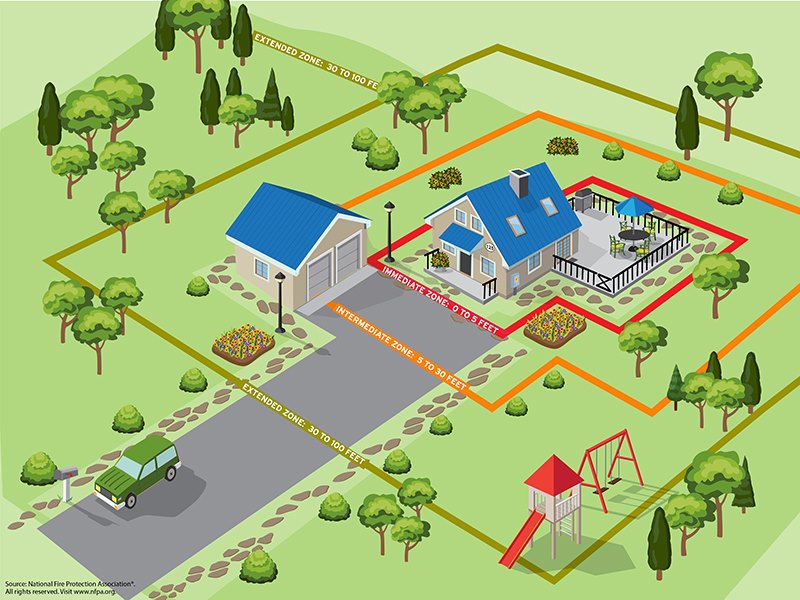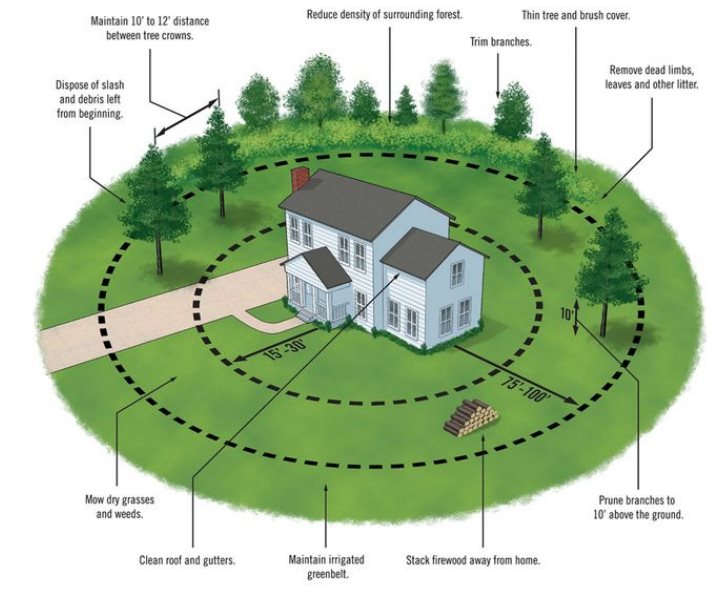Fire Prevention –Defensible Tree Landscaping!
How to make your home and property fire-safe?

Fire can approach your home from any direction, through the trees in your neighbor’s or even your property. Global warming and the growing drought mean wildfires, especially in California; everyone has to be aware of the dangers of wildfires.
Protect your home by creating defensible space around your house’s perimeter; it’s a proven way to make it less vulnerable to wildfire. A secure area means maintaining the landscape around a home to stop the advance of a wildfire. The space also provides safe access for firefighters so they can protect it. Defensible space is grouped into three zones.
Defensible space is the buffer you create between a building on your property and the grass trees shrubs for any wildland area that surrounds it. Think of this as circles around your house. Closest to your home–zero to five feet–ideally, there wouldn’t be anything flammable.
Zone one: Immediate zone

The goal of zone one or the immediate location is to minimize ignition sources, which starts with the home itself. Using fire-resistant materials for your home and deck, along with fire-safe construction techniques, will help prevent airborne embers from igniting your home.
Keep your structure clean.
Clean the places like roofs, gutters, decks, or any place where debris can accumulate. Replace mulch around your house with non-combustible materials such as crushed rock or stone and within 5 feet of the home, remove all plant material living and dead. And take a moment to look up. For example, are there any branches overhanging the roof? You want to remove those as well.
The area within five feet of your house is the most critical. During a wildfire, embers can travel long distances. They tend to collect near the base of a home’s exterior walls and ignite anything that burns. To avoid that, minimize anything that can burn in this area, including wood, mulch, and plants, which means moving items like firewood, lumber, patio furniture, and garbage cans. Clearing this area of combustibles is like creating a force field that defends your home against fire.
Just take it to step by step!
- Start by removing plants in front of sliding glass doors or windows and remove any wood mulch. Next, focus on taller plants under eaves and vines climbing on your house.
- Low-growing or ground-hugging plants are less likely to cause a problem. Just be sure they’re well hydrated and free of dead or dry material. Beyond 5 feet from the house, it’s all about maintenance.
- The goal is to create a defensible space that acts as a buffer between your house and garden. It means looking at your garden with slightly different eyes.
Zone two: Intermediate zone

The goal of zone two is to reduce and spaced flammable vegetation to slow the fire spread and keep it on the ground, making it difficult to reach the house. Consider your choice of plants in this zone. Choosing low-growing and fire-resistant plants will help reduce ignitions in the spread of fire.
Lawn protection
Lawns are a good choice but keep them well watered and mowed to a height of 4 inches or less. Lawn, driveways, and gravel paths act as fuel brakes to help slow the fire and get it to drop to the ground. But, of course, fire is the best control when it’s on the basis, so another goal for this zone is to eliminate ladder fuels known for helping a ground fire climb up into the treetops, that could be shrubs near a tall tree or even low branches.
So, remove vegetation from around trees and prune limbs 6 to 10 feet up from the ground. And as was done in the previous zone, remove all cones, needles, leaves, and branches from the ground, and if you have a woodpile, make sure that you move it at least thirty feet away from home, preferably upslope.
Zone three: Extended zone
This zone is the first line of defense. There may be more plants and trees in this zone, but if they’re spaced and pruned correctly, they’ll provide a suitable buffer that can slow the advance of a forest fire by starving in fuel.
If you’ve got small clusters of trees, make sure they’re at least thirty feet away from other groups of trees. Individual trees should be at least ten feet apart. Although you still should eliminate ladder fuels so that fire doesn’t climb from the ground into the canopies of tall trees.
Remember to prune limbs six to ten feet (6 to 10 feet) up from the ground. Remove significant accumulations of woody debris such as dead trees or piles of downed branches, needles, or leaves. And although it’s a vast operation, fitting trees in this zone can make a big difference; by reducing the number of trees and spacing out the crowds, you can reduce the spread of fire while maintaining a beautiful landscape.

Final steps to create and keep a fire-safe tree landscaping!
Once you’ve created a defensible space, there are some additional steps you can take to help protect yourself.
Make sure your address is marked and that large fire trucks have easy access to your home.
Evacuation plans need to be ready and rehearsed long before a wildfire threatens. The time you have to avoid an approaching fire and evacuate could only be a matter of minutes, and you need to act quickly.
With these preventative efforts, you can help slow or stop the spread of a fire before it reaches your home. Talk to a fire prevention specialist for your individual property and talk to your neighbors to see what they’re doing to make your community fire safe.
Find out more by contacting your local extension forester, a fire prevention specialist, or visiting the Bay Tree Removal Service website.
Arborist’s service
- Pruning services for fruit, roses, and small trees
- Pest management
- Tree risk and hazard assessment
- Tree appraisal and value assessment.’
- Tree prevention and protection plan
- Tree planting and design for acreage owners
Fire-smart landscaping

How to create and maintain a beautiful fire-smart landscape?
Most traditional residential landscapes include foundation plantings and large trees and shrubs near the house. We’re used to this look, but it turns out there are better ways of organizing your landscape that may help protect your home when a wildfire is burning nearby.
Professionals often asked the question, “what are the safest plants?”
The truth is all plants burn. So, when it comes to fire thoughtful landscaping, it’s much more important to consider where a plant is situated and how it is maintained than to assume some plants are better than others.
Interrupt the path of the fire
First, you want to interrupt the path of fire by creating horizontal and vertical spacing between plants. That doesn’t sound very easy, but it’s not. You can create flat space by adding stepping stones, paths, patios, or walls. Any non-combustible surface between plantings helps stop the direction of fire. They can be as simple as gravel paths or as complicated as a low stone wall.
Think of planting beds as clumps or islands
The idea is to think of your planting beds as clumps or islands with non-combustible surfaces providing separation to keep a fire from spreading along the ground.
- Vertical spacing is about stopping fire ladders. Fire ladders are when fire from lower plants spreads to nearby taller plants. If you stroll through your garden, are there places where shrubs are close to low tree canopies? If so, try to create space between them.
- Limb up trees and keep shrubs pruned. It’s an easy and essential way of interrupting the path of a fire. The density of plantings provides another clue about how a fire could travel through your garden.
- A little breathing space in your garden is a must. Consider breaking up hedges and large swaths of uninterrupted plantings to stop the fire in its tracks.
- Another good rule of thumb is to keep low-growing plants closer to the house and taller plants away from home.
Reduce fuel loads
Reducing fuel loads is a fancy way of saying keep your garden cleaned up. Anything that burns is fuel for a fire.
Diseased dried or overgrown trees and shrubs have more fuel than well-pruned trees and shrubs. So do weeds, leaves and pine needles and roof gutters, and debris that’s gathered under decks.
Keep things cleaned up to starve the fire of fuel. But, as we like to say, don’t be foolish! Don’t worry, and you don’t need to pick up every last leaf on the ground. Just be on the lookout for excess fuel, being extra vigilant the closer you are to your home or other built structures.
Do you see plant material that would be useful for starting a campfire?
If so, that’s probably a good clue that it needs to be removed. So, step into your garden and look up.
Do you see tree branches near the roofline?
Try to keep units ten feet from your roof or chimney and not touching the walls of your house. That way, you’ll avoid a buildup of needles and leaves on your roof in your rain gutters.
Are there any diseased, dead, or dried shrubs or trees that need to be pruned or removed? Now look down. Are paths clear of debris? Do plants look healthy and hydrated?
Plants that are adequately hydrated are more resistant to fire into pests and diseases. Even some drought-resistant plants may need a little supplemental water during extended dry periods.
What about mulch?
A layer of mulch improves soil quality, regulates soil temperature, reduces weeds, and helps retain water. Use non-combustible mulches like stone or gravel within 5 feet of any structure, including decks and sheds. Further out, choose larger composted wood chips and avoid applying mulch greater than 2 inches deep.
Choosing plants! A favorite topic for master gardeners
We recommend plants that don’t need much water, are easy to maintain, and then contribute to the ecological health of the surrounding area. We also have suggested avoiding plants that are messy or invasive, like ivy and pampas grass. Meaning they grow or spread so fast it’s hard to keep them under control.
Remember, you’re trying to reduce your fuel load. Start by assessing your garden’s growing conditions, such as sun exposure and climate, and then select plants that thrive in that environment. In other words, choose the right plant for the right place.
Tree removal in Hayward, CA - Bay Tree Removal Service
Creating your fire safety plan may take a unique approach because your topography, climate, and surroundings are unique to you and your land. To help make a plan, feel free to contact The Bay Tree Removal Service, Hayward, CA. We are ready to provide you THE BEST tree care and landscaping suggestions and tree trimming, pruning, removal services, etc. Call at (510) 250-5158 and get expert advice to keep your property fire-safe.

